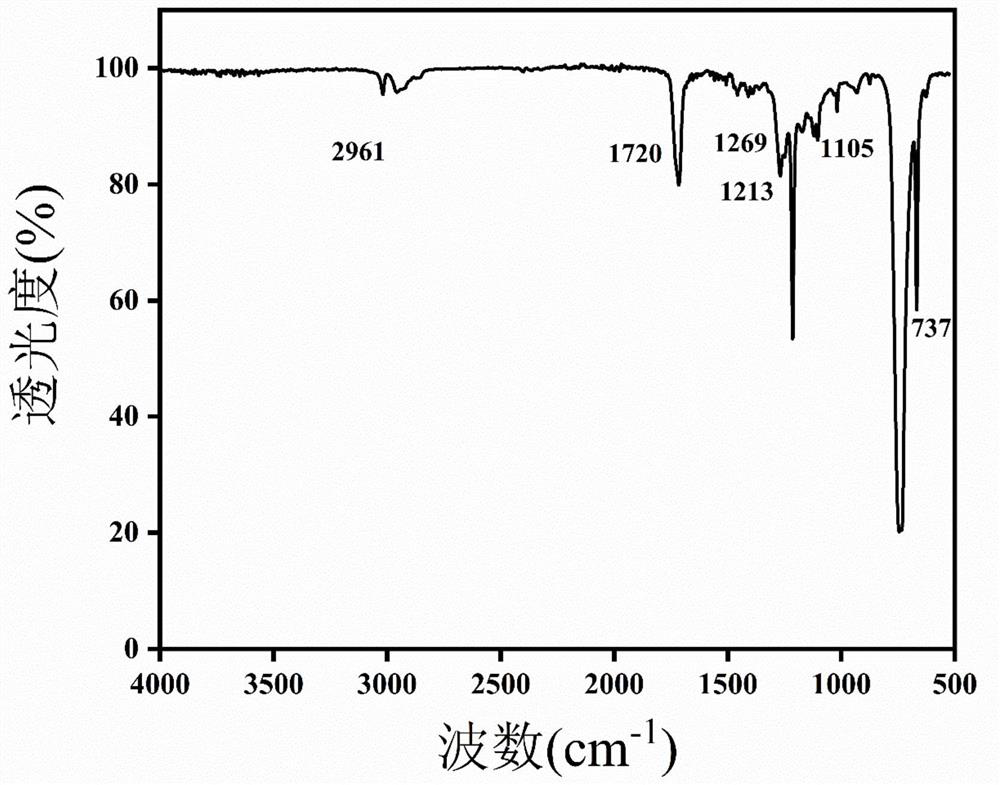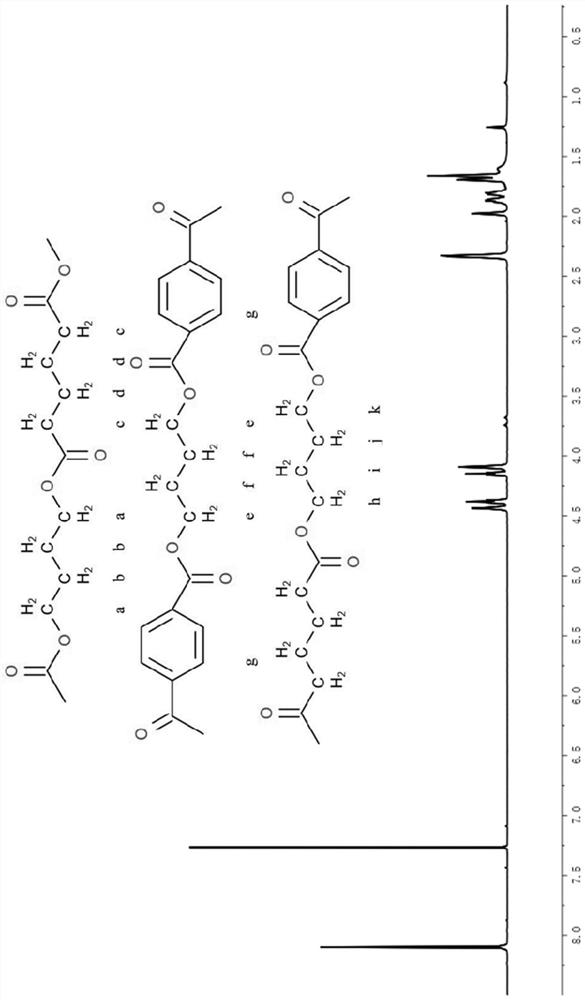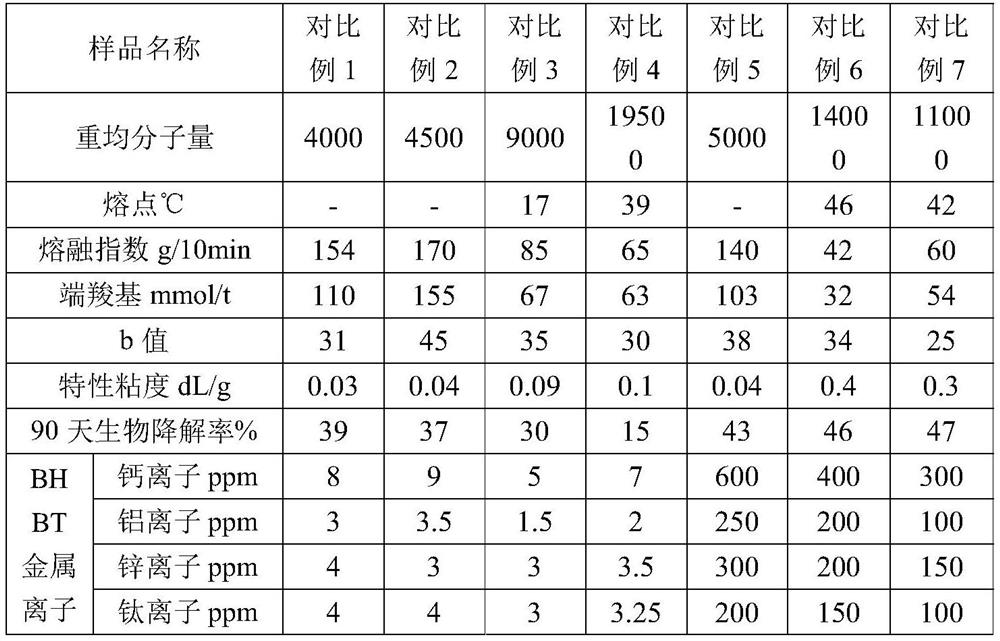Degradable PBAT polymer regenerated from waste PBT and preparation and application thereof
A polymer and polycondensation reaction technology, applied in the direction of one-component polyester rayon, adhesives, etc., can solve the problems of difficulty in large-scale promotion and application, affecting product quality, and difficulty in polymerization, so as to solve the problem of single recycling and reproducing, and realize the Low-carbon and green use of the environment and the effect of improving economic benefits
- Summary
- Abstract
- Description
- Claims
- Application Information
AI Technical Summary
Problems solved by technology
Method used
Image
Examples
Embodiment 1
[0057] A preparation method for regenerating waste PBT into degradable PBAT polymer, the concrete steps are as follows:
[0058] (1) Treatment of waste PBT: The waste PBT material derived from the scraps of injection molding parts for vehicles is processed to obtain PBT powder with a particle size of less than 2 mm, and then sieved. Finally, the PBT powder is placed in a vacuum oven at 100 ° C for drying for 12 hours ;
[0059] (2) Preparation of the regenerated monomer BHBT: take the dried PBT powder, 1,4-butanediol, catalyst, anti-aging agent and anti-ether agent in step (1) and add it to the reaction kettle, pass nitrogen protection , dissolve at 180 °C, gradually heat up to 220 °C after the system is clarified, and keep this temperature for 1.8h reaction; record the water output, when it reaches 90% of the theoretical value, it can be evacuated, and the vacuum degree of the control system is 1000Pa, and the control time is 30min; Then add a complexing agent, react after 1...
Embodiment 2
[0079] A preparation method for regenerating waste PBT into degradable PBAT polymer, the concrete steps are as follows:
[0080] (1) Treatment of waste PBT: The waste PBT material derived from the scraps of injection molding parts for vehicles is processed to obtain PBT powder with a particle size of less than 2 mm, and then sieved. Finally, the PBT powder is placed in a vacuum oven at 120 ° C for drying for 8 hours ;
[0081] (2) Preparation of the regenerated monomer BHBT: take the dried PBT powder, 1,4-butanediol, catalyst, anti-aging agent and anti-ether agent in step (1) and add it to the reaction kettle, pass nitrogen protection , dissolve at 195 ℃, gradually heat up to 230 ℃ after the system is clarified, keep this temperature for 2h reaction; record the water output, when it reaches 90% of the theoretical value, it can be evacuated, the vacuum degree of the control system is 500Pa, and the control time is 20min; then Add complexing agent, react after 15min, filter unr...
Embodiment 3
[0101] A preparation method for regenerating waste PBT into degradable PBAT polymer, the concrete steps are as follows:
[0102] (1) Treatment of waste PBT: The waste PBT material derived from textile scraps is processed to obtain PBT powder with a particle size of less than 2 mm, and then sieved, and finally the PBT powder is placed in a vacuum oven at 110 ° C for drying for 6h;
[0103] (2) Preparation of the regenerated monomer BHBT: take the dried PBT powder, 1,4-butanediol, catalyst, anti-aging agent and anti-ether agent in step (1) and add it to the reaction kettle, pass nitrogen protection , dissolve at 200 ℃, gradually heat up to 210 ℃ after the system is clarified, keep this temperature for 1.5h reaction; record the water output, when it reaches 90% of the theoretical value, it can be evacuated, the vacuum degree of the control system is 100Pa, and the control time is 45min; Then add a complexing agent, react after 18min, filter the unreacted material while hot to obt...
PUM
| Property | Measurement | Unit |
|---|---|---|
| Particle size | aaaaa | aaaaa |
| Melting point | aaaaa | aaaaa |
| Melt index | aaaaa | aaaaa |
Abstract
Description
Claims
Application Information
 Login to View More
Login to View More - R&D Engineer
- R&D Manager
- IP Professional
- Industry Leading Data Capabilities
- Powerful AI technology
- Patent DNA Extraction
Browse by: Latest US Patents, China's latest patents, Technical Efficacy Thesaurus, Application Domain, Technology Topic, Popular Technical Reports.
© 2024 PatSnap. All rights reserved.Legal|Privacy policy|Modern Slavery Act Transparency Statement|Sitemap|About US| Contact US: help@patsnap.com










